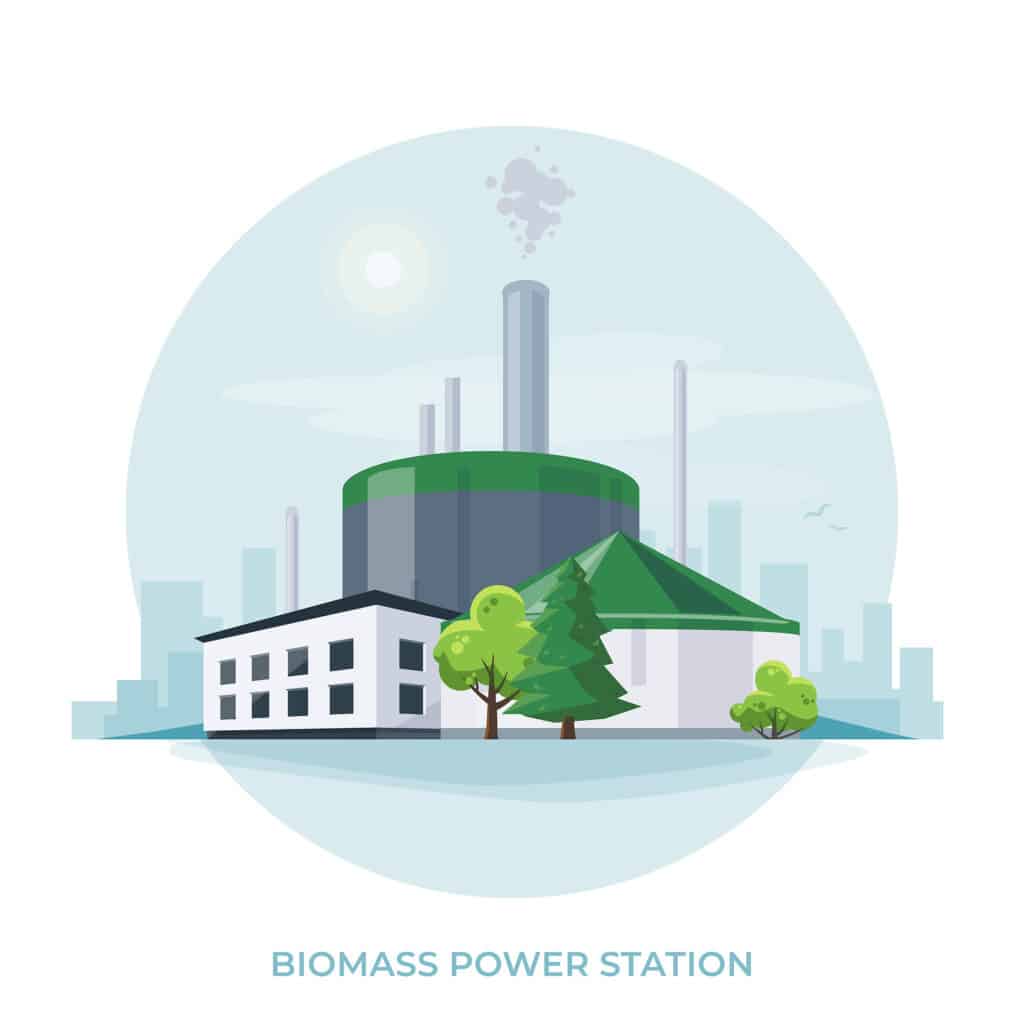Sustainable Energy Source: How Biomass Energy Keeps the World Turning
As our company takes bold steps towards embracing renewable energy sources, we are increasingly intrigued by the immense potential of biomass energy. This versatile and sustainable resource has captured our attention, and we are eager to explore how it can play a significant role in reducing greenhouse gas emissions and combatting climate change.
In this blog post, we aim to delve into the world of biomass energy, understanding its essence, uncovering its benefits, exploring various biomass fuels available, investigating cutting-edge technologies for biomass power generation, and addressing the challenges faced by the biomass energy industry. Ultimately, we'll gaze into the future of biomass energy in biomass and how it aligns with our vision to reduce our dependence on fossil fuels while contributing to a greener tomorrow.
What is Biomass?
Biomass is a term used to describe any organic material that is derived from living or recently living organisms. This can include plants, animals, and microorganisms such as bacteria and fungi. The sources of biomass can vary widely, from agricultural waste and forest residues to dedicated energy crops like switchgrass or willow trees.
Biomass is considered a renewable energy source because the carbon that is stored within the organic matter can be replenished over time through the process of photosynthesis. During photosynthesis, plants and other organisms absorb carbon dioxide from the atmosphere and convert it into organic matter through the use of sunlight, water, and nutrients. When this organic matter is burned or converted into biofuels, the stored carbon is released as energy.
There are several different ways that biomass can be used to produce energy. One common method is through combustion, where biomass is burned to generate heat or steam that can be used to produce electricity. Biomass can also be converted into biofuels such as ethanol or biodiesel through a variety of chemical processes.

Benefits of Biomass Energy
Renewable and Sustainable
Biomass energy is derived from organic materials that can be regrown or replenished within a relatively short period. Unlike finite fossil fuels, such as coal, oil, and natural gas, which take millions of years to form, biomass resources, like crops, trees, and other plants, can be cultivated and harvested annually. This renewability ensures a continuous and sustainable energy supply, reducing the pressure on non-renewable resources and supporting long-term energy planning and stability.
Diverse Feedstock Options
Biomass energy offers a wide range of feedstock options, making it highly versatile and adaptable to different regional contexts and energy needs. Various biomass sources, including agricultural residues, energy crops, algae, and organic waste, can be used for energy production. This diversity allows countries to tailor their biomass utilization to their specific environmental conditions, available resources, and energy demands.
Peaking Power and Grid Stability
Biomass energy systems can provide peaking power to the electrical grid, serving as a reliable backup during periods of high electricity demand. Biomass power plants can quickly ramp up their production to meet spikes in energy consumption, ensuring grid stability and preventing power shortages during peak hours. This ability to complement intermittent renewable energy sources like solar and wind makes biomass an essential component of a balanced and resilient energy mix.
Carbon Sequestration
Certain biomass practices, such as afforestation and reforestation, can help sequester carbon dioxide from the atmosphere. Planting and maintaining trees and other carbon-absorbing vegetation not only contributes to biomass feedstock availability but also actively aids in mitigating climate change by locking away carbon in living biomass and soil, thus helping to offset emissions from other sectors.
Local Economic Growth and Energy Independence
Investing in biomass energy projects can revitalize local economies and strengthen energy independence. By encouraging the development of biomass facilities, communities can create new revenue streams, attract investments, and support local businesses. Moreover, as biomass for energy production is often decentralized, communities can become less reliant on centralized energy grids and imported fuels, fostering greater uses of biomass energy independence and resilience.
Utilization of Marginal Lands
Biomass crops and energy plantations can be grown on marginal lands, which are not suitable for conventional agricultural activities. By utilizing these less productive areas for biomass production, we can avoid competing with food crops for fertile land, thereby addressing concerns related to food security and preserving valuable ecosystems.
Reduction of Air Pollution
Biomass energy, when compared to burning fossil fuels, generally emits lower levels of harmful pollutants, such as sulfur dioxide, nitrogen oxides, and particulate matter. This can lead to improved air quality and fewer respiratory health issues in communities near biomass power plants.
Support for Rural Communities
Biomass energy projects can provide additional income streams for farmers and landowners. By growing energy crops or supplying biomass feedstock, rural communities can diversify their revenue sources and stabilize their income throughout the year.

Types of Biomass Energy Sources
There are numerous types of biomass that can be used for energy production, each with its unique properties and advantages.
Agricultural Residues
Agricultural residues encompass a wide range of leftover materials from farming activities. These include crop residues like corn stalks, wheat straw, sugarcane bagasse, and rice husks, as well as by-products like straw and husks. These materials are abundant and often left unused or discarded after harvest. By harnessing agricultural residues for biomass energy production, we can utilize these otherwise wasted resources and create a valuable energy source.
Forestry Waste
Forestry waste consists of the residual biomass generated from various forestry activities. This includes logging residues, such as tree branches, treetops, and bark, as well as tree stumps and dead trees that are typically left behind after logging operations. Converting forestry waste into biomass as an energy source not only reduces the environmental impact of forestry practices but also maximizes the utilization of the entire tree, turning what would be waste into a valuable energy resource.
Municipal Solid Waste (MSW)
Municipal Solid Waste, commonly known as household or urban waste, comprises the everyday items discarded by households, businesses, and institutions. MSW includes food scraps, paper, cardboard, plastics, yard waste, and other organic materials. By employing advanced technologies like anaerobic digestion or waste-to-energy incineration, we can process MSW and convert it into biomass energy comes from, reducing the volume of waste that goes to landfills and simultaneously generating renewable energy.
Dedicated Energy Crops
Dedicated energy crops are specifically cultivated for their potential to serve as biomass feedstock. These crops are chosen for their fast growth rates, high energy content, and suitability for various climates and soil types. Examples of dedicated energy crops include fast-growing trees like willow and poplar, perennial grasses such as switchgrass and miscanthus, and energy-rich plants like jatropha and camelina. These crops offer the advantage of efficient biomass production and can be grown on marginal lands not suitable for traditional food crops, thus minimizing competition for arable land.
Algae
Algae, both macroalgae (seaweeds) and microalgae, have emerged as a promising sources of biomass energy due to their rapid growth rates and high oil content. Algae can be cultivated in various aquatic environments, including ponds, tanks, and even open seawater. Unlike terrestrial plants, algae do not require arable land, meaning they do not compete with food crops for valuable farming areas. Additionally, algae's ability to produce biofuels more efficiently than traditional crops makes them a highly attractive option for sustainable biofuel production.
Animal Waste
Animal waste, such as manure, can also be utilized as a biomass energy source. Anaerobic digestion processes can convert animal waste into biogas, a renewable energy source rich in methane. This biogas can then be used for electricity generation, heating, or as a vehicle fuel, providing a sustainable and environmentally friendly alternative to conventional fossil fuels.
Industrial and Food Processing Residues
Industries and food processing facilities generate significant amounts of organic waste, such as wood residues, sugarcane bagasse, and fruit and vegetable peels. By harnessing this biomass waste, industries can not only reduce disposal costs but also convert it into energy to power their operations, fostering a circular economy approach.
Biomass Power Generation Technologies
There are several technologies used for biomass power generation, including:
Direct Combustion
Direct combustion is one of the oldest and most straightforward biomass power generation technologies. In this process, biomass feedstock, such as wood chips, agricultural residues, or energy crops, is burned directly in a combustion chamber to produce high-temperature steam. The generated steam is then used to drive a turbine connected to an electricity generator, converting the kinetic energy of the turbine into electrical power. Direct combustion is efficient, cost-effective, and widely adopted in biomass power plants, especially for applications where a reliable and continuous electricity supply is required.
Gasification
Gasification is an advanced biomass conversion technology that converts biomass into a combustible gas known as “syngas” or “producer gas.” The process involves heating the biomass in a controlled environment with a limited supply of oxygen (partial oxidation) or other gasifying agents. The resulting syngas primarily consists of carbon monoxide (CO), hydrogen (H2), methane (CH4), and carbon dioxide (CO2). The syngas can be utilized in gas engines or turbines to produce electricity or can be further refined into biofuels or valuable chemicals. Gasification offers greater efficiency and flexibility than direct combustion, allowing for the conversion of a broader range of biomass feedstocks and enabling a more efficient use of the energy content in the biomass.
Anaerobic Digestion
Anaerobic digestion is a biological process that occurs in the absence of oxygen, where microorganisms break down organic matter, such as animal manure, agricultural residues, and food waste, to produce biogas. Biogas is primarily composed of methane (CH4) and carbon dioxide (CO2) and can be used to generate electricity and heat through the combustion process or utilized directly as a vehicle fuel or for cooking. Anaerobic digestion not only provides renewable energy but also offers the additional benefit of treating organic waste, reducing its environmental impact and producing valuable organic fertilizers as by-products.
Co-firing
Co-firing involves the simultaneous combustion of biomass and coal in existing coal-fired power plants. By co-firing biomass alongside coal, power plants can reduce their reliance on fossil fuels and decrease greenhouse gas emissions. The biomass can be in the form of wood pellets, agricultural residues, or other waste materials, which are blended with coal and fed into the boiler for combustion. Co-firing is considered a transitional solution to incorporate renewable energy into existing coal-based infrastructure, providing a cost-effective way to reduce carbon emissions and transition to a more sustainable energy mix.
Pyrolysis
Pyrolysis is a thermochemical conversion process that decomposes biomass in the absence of oxygen at high temperatures. This process results in the production of bio-oil (also known as pyrolysis oil or bio-crude), biochar (a solid carbon-rich residue), and syngas. The bio-oil obtained from pyrolysis can be utilized for heat production, as a fuel in industrial processes, or further refined into biofuels, such as bio-diesel. Biochar, on the other hand, can be used as a soil amendment to enhance soil fertility and sequester carbon. Pyrolysis offers a unique opportunity to obtain a liquid biofuel that can be readily integrated into existing fuel infrastructures, making it a promising technology for sustainable energy production and carbon management.

Challenges Faced by Biomass Energy Industry
Despite the numerous benefits of biomass-energy, there are several challenges faced by the biomass energy industry, including:
High Capital Costs
Biomass power generation technologies typically involve complex equipment and processes, leading to higher initial capital investments compared to conventional fossil fuel power plants. For instance, gasification and pyrolysis facilities require advanced equipment and sophisticated control systems to ensure efficient conversion of biomass into energy products. The higher capital costs can deter investors and make it challenging for biomass energy projects to compete with established fossil fuel-based energy sources, especially in regions with abundant and inexpensive fossil fuels.
Supply Chain Issues
Biomass fuels, such as wood chips, agricultural residues, and dedicated energy crops, often have lower energy density and higher moisture content compared to fossil fuels. As a result, large volumes of biomass are required to produce a comparable amount of energy. Transporting and storing such bulky materials can be logistically demanding and costly. Moreover, the supply of biomass fuels can be affected by seasonal variations, crop yields, and weather conditions, introducing uncertainties in the availability and pricing of feedstock.
Land-Use Conflicts
Biomass energy production may lead to land-use conflicts, particularly in regions where land resources are limited or competing demands exist. The cultivation of dedicated energy crops for biomass can sometimes compete with land used for food production or conservation purposes. Striking a balance between land allocation for various purposes is crucial to ensure sustainable and responsible biomass energy development without compromising food security or natural ecosystems.
Emissions and Air Quality
Although biomass energy is considered a renewable energy source, the combustion of biomass fuels can produce emissions that impact air quality. Particulate matter, nitrogen oxides, volatile organic compounds, and other pollutants may be released during the combustion process. While some modern biomass power plants incorporate emission control technologies to mitigate these effects, older or less well-maintained facilities may present challenges to maintain air quality standards. Proper management and regulation are necessary to address emissions and minimize their impact on public health and the environment.
Technological Development and Efficiency
Advancements in biomass energy technologies are ongoing, and achieving high levels of efficiency and cost-effectiveness is an ongoing challenge. Research and development efforts are needed to improve the performance of biomass conversion processes, enhance feedstock logistics, and optimize energy production. Increasing the efficiency of energy conversion and reducing operational costs are vital to making biomass energy more competitive with other renewable and non-renewable energy sources.

Future of Biomass Energy
The future of biomass energy holds great promise as societies worldwide increasingly prioritize the adoption of renewable energy sources. Governments and businesses are recognizing the numerous benefits of biomass-energy, propelling investments in research and development to advance biomass power generation technologies. These efforts have yielded remarkable improvements in efficiency and cost reduction, making biomass energy more competitive with conventional fossil fuel-based options.
A key aspect of the future lies in the integration of biomass energy with other renewable sources, such as wind and solar. By combining different renewable energy technologies, we can create more reliable and consistent energy systems that are less dependent on weather conditions. This synergy between biomass and other renewables contributes to a more stable and resilient energy grid, capable of meeting growing energy demands while reducing reliance on fossil fuels.
Moreover, the potential of biomass energy extends beyond electricity generation. There is a growing interest in utilizing converting biomass to energy resources for the production of biofuels, such as biodiesel and ethanol. These advanced biofuels can serve as eco-friendly alternatives to traditional fossil fuels in the transportation sector. By replacing conventional gasoline and diesel with biofuels, we can significantly mitigate greenhouse gas emissions, combat climate change, and reduce our dependence on finite fossil fuel reserves.
Conclusion
In this thought-provoking blog post, we explore the potential of biomass energy and its role in reducing greenhouse gas emissions and combatting climate change. From understanding the essence of biomass to uncovering its benefits, various biomass fuels, and cutting-edge technologies, the article sheds light on the challenges faced by the industry and the future of biomass energy.
Biomass, derived from organic materials, offers renewable and diverse feedstock options that promise a sustainable energy supply. Its advantages extend beyond electricity generation, encompassing carbon sequestration, local economic growth, and utilization of marginal lands. However, high capital costs, supply chain issues, and land-use conflicts present hurdles that must be addressed for wider adoption.
The future of biomass energy lies in integrating it with other renewables and exploring its potential as a source for advanced biofuels. By leveraging innovation and efficiency, we can build a greener and more resilient energy landscape. Embracing biomass energy reflects our commitment to sustainability and a brighter future, where clean and renewable energy drives us toward a vibrant tomorrow.
Sources
International Energy Agency. (2020). Renewables 2020. Retrieved from https://www.iea.org/reports/renewables-2020
National Geographic. (2021). Biomass energy. Retrieved from https://www.nationalgeographic.org/encyclopedia/biomass-energy/

